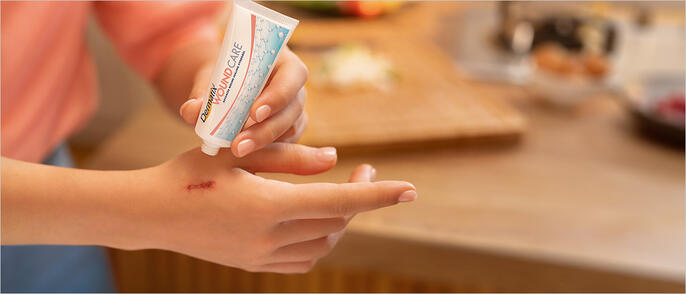Busting Myths About Wounds
Wounds are a part of everyone’s life, whether they’re minor cuts, scrapes and burns, or more serious injuries. And while wounds are certainly not to be feared, they’re also not to be taken lightly – as improper treatment of wounds, can result in infections and worse scarring (than expected).
On this note, you’ve probably heard conflicting advice about wounds (and wound care) over the years – such as, ‘put a plaster over your wound’ and ‘let your wound breathe’. So, what’s real and what’s not? Today, we’re going to bust some of the most common myths about wounds.
Myth 1
Wounds must breathe to heal


We’ve placed this myth at the top of this list, because it’s possibly the most commonly perpetuated myth of all. Wounds need moisture – not air – to heal. By not covering your wound in a clean and sterile dressing, you’re exposing the wound to bacteria, dirt and possibly further injury (thought knocks and scratches).
To sum it up, wounds don’t need to ‘breathe’ – so always cover your wounds and protect them as they heal.
Myth 2
Keep your wound dry, or bacteria will grow


In our “Proper wound care: Is disinfecting enough?” article, we discussed how the reverse is true – and that in fact, an optimally moist environment prevents tissue dehydration, accelerates the development of new blood vessels, and speeds up the breaking down of dead tissue.
The solution to avoiding bacteria growth isn’t to ‘keep your wound dry’ (as bacteria can still be present on a dry wound), it’s to first clean and disinfect the wound, apply an intelligent hydrogel (like Dermatix® Wound Care ) to form a barrier on the wound1, then use a dressing to protect it physically.
Myth 3
Wounds must form a scab to heal properly


Here’s another myth that has led to many adults and children leaving their wounds exposed to the environment, instead of being kept moist and covered. While scabbing is a natural part of the healing process, it doesn’t always happen, and certainly isn’t necessary for proper healing.
Often, when a wound is kept moist, the likelihood of a scab forming is decreased (which is unfortunately why many people don’t cover wounds). Whether or not a scab forms, the same rules apply – as long as your wound is kept moist, the scab will not inhibit the healing process.
So, don’t worry whether a scab forms during healing. Simply keep your wound clean, moist, protected with a hydrogel like Dermatix® Wound Care , and covered – and you’ll be on your way to a smooth (as possible) recovery!
Myth 4
A properly healed wound will never leave a scar


Scars are a natural part of the body’s healing process, and happen when your body forms new collagen fibres to mend the damaged area. After some time, the collagen build up results in tissue that has a different texture and quality from the surrounding tissue.
This is what we know as a scar, and as you can see, it’s simply a result of your body healing itself. While proper wound care won’t guarantee that a scar won’t be present after healing, improper wound care can increase the likelihood of a more noticeable scar.
Should a scar form, don’t worry. Just switch to scar management with a treatment like Dermatix® Ultra, which is proven to lighten, soften and flatten scars.2,3,4 (In fact, Dermatix® Ultra has demonstrated an over 85% success rate in softening and diminishing the appearance of hypertrophic and keloid scars.4, 5)
Myth 5
No need for stiches, glue can close a wound!


First of all, this ‘glue’ you may have heard about, most certainly isn’t the same glue that’s available off the shelf at your local supermarket or hardware store. Also, even if you do manage to get the same type of glue that doctors use, it’s never a good idea to administer this ‘treatment’ at home.
Incorrect use of glue on wounds can lead to skin irritation, allergic reactions, delayed healing, as well as other inconveniences and medical issues. If your wound is serious enough to warrant stiches or medical-grade adhesive, please put aside any thought of this ‘home remedy’ and visit a doctor or hospital as soon as possible.
Should you have any questions on caring for your wound, please speak to your doctor for professional advice.



- Zhang L, et al. Dermatol Ther (Heidelb). 2020 Oct;10(5):1075-1088
- Yun IS, et al. Aesth Plast Surg (2013) 37:1176-1181
- Chernoff WG, et al. Aesth Plast Surg 2007;31:495-500
- Fulton JE. Silicone gel sheeting for the prevention and management of evolving hypertrophic and keloid scars. Dermatol Surg 1995;21:947-951
- Mercer NSG. Silicone gel in the treatment of keloid scars. Br J Plastic Surg. 1989;42:83-87



